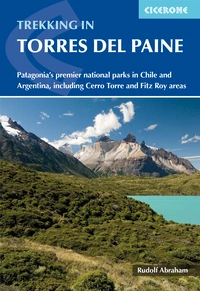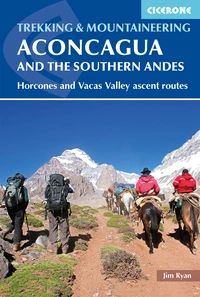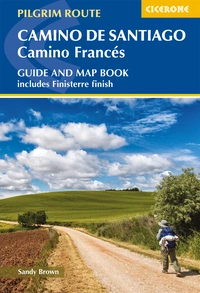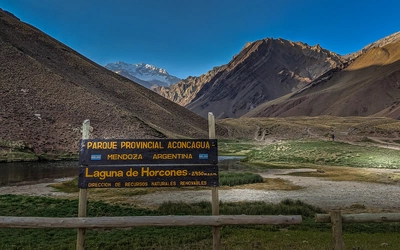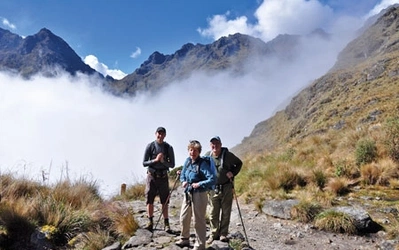Trekking down south: the W trek in Torres del Paine
On a trip to Patagonian Chile, Cicerone sales agent James Benson explored the mountains, lakes and glaciers of Torres del Paine National Park.
The wind here can blow you over, and coming straight off the cold, grim, grey sea, it didn’t feel much like the holiday down south I had imagined.
I mentioned that we were in training for a holiday down south when I wrote my recent account of walking the Yorkshire Three Peaks. Now past sixty, it seemed time to slow things down a bit. Given that Cicerone were publishing Walking in the New Forest in February, what better idea than to go south to Brockenhurst and Lymington and take in some gentle woodland strolls in the early springtime, maybe stopping to pat a few ponies and enjoy leisurely pub lunches in woodland English villages dappled by early spring sunshine.
“Doesn’t look much like the Solent,” I muttered to myself as I hunkered down by the thunderous giant mylodon statue, watching a rusty little tanker battering its way through the savage squalls driving down Last Hope Sound, “but I suppose it is down south.”
No, those savage black rocks weren’t The Needles with their jaunty lighthouse. We weren’t in Lymington or Beaulieu, but had decided to forego the lovely county of Hampshire until another time. This was Puerto Natales in Patagonian Chile, and we were about to walk the 'W' trek in the Torres del Paine National Park.

After John Hillaby and Walt Unsworth, an early inspiration for my walking was Bruce Chatwin. In Patagonia arguably created a whole new genre of travel writing. Much of Chatwin’s traveling was undertaken on foot (if he is to be taken at face value). His first, highly original and often hilarious book took a scrap of mylodon skin found at a now famous cave just north of Puerto Natales as its jumping off point.
Puerto Natales is a rufty tufty fishing port that has adopted the mylodon or giant ground sloth as a mascot (think a giant gloomy Paddington) and is now the main departure point for the Torres del Paine National Park to the north. The local airstrip recently opened to commercial jets, which potentially avoids a longer trip in from the city of Punta Arenas down on the Magellan Straits.
We travelled north into the National Park on a public bus as part of a trekking group of eleven, led by three fantastic local guides whose enthusiasm and passion for their wonderful countries came across at every footstep. They were Chilean and Argentine and the banter, like the landscape, was world class.
A two-hour public bus drive took us through desolate rolling hills, the brooding landscape dotted with far-away mountains resembling dinosaurs. Distant Cerro Pinaculo over the border in Argentina seemingly lumbered around, as the bus meandered its way to the National Park entrance at Amarga.

Trekking in Torres del Paine
Patagonia's premier national parks in Chile and Argentina, including Cerro Torre and Fitz Roy areas
£18.95
Guidebook to trekking Chile's 10 to 11-day Torres del Paine Circuit, one of the world's great treks. Also included are a shorter Half Circuit (4 to 5 days), further treks and day walks in the Torres del Paine and Los Glaciares National Parks, centred around Puerto Natales. Includes information on linking routes, travel and accommodation.
More informationThe W trek is perhaps the best known of the Torres del Paine walks. A 70km hike along the southern skirts of the mountains, taking in three roughly parallel valleys cutting up northwards into the massif, so that the walk appears as a rough W shape on the map. If you are really fit, you can circumnavigate the entire range by undertaking the 110km O Trek. All of this is expertly and succinctly described in Rudolf Abraham’s Trekking Torres del Paine which, together with a Zagier map from Stanfords, we found truly invaluable on our walk.
Access to the park is strictly monitored and controlled. Devastating fires, at least one of which was started by a walker setting light to toilet paper, have laid waste to swathes of the flora in recent years. We, like everyone were given a friendly but pretty strict welcome by wardens on arrival at Amarga.
The park is studded with accommodation options, and most visitors will stay a night or more at one of the superb refuges under the mountains to the north of Lakes Pehoe and Nordenskjold. Our group, unusually perhaps, chose a quieter, smaller campsite to the south of Lago Pehoe. The door to the shower block, facing the wall of mountains across the lake, must boast one of the most extraordinary vistas of such a facility anywhere in the world.

Camping here meant that we commuted into the trek for three days, crossing the lake on the first and the last catamaran ferries of the day. Missing the 35 minute ferry ride would ruin the whole day. Space on the boat is limited, so we enjoyed early starts and late finishes before long days of walking. Trekking here is full-on: breaks minimal and good fitness essential. Our Yorkshire Three Peaks walk stood us in excellent stead. The peaks rise to over 3000 metres from near enough sea level, and the final day’s walk to the mirador at the base of the famous towers rises around 900 metres over 18km. The trails are outstanding though. Well built, with occasional boardwalks and wonderfully airy bridges.
You might be at the end of the world, but if you travel there in season like us, you will find that everyone else is at the end of the world too. The National Park attracts over 250,000 visitors a year and it was quite crowded at times, especially on the last day’s hike up to the Torres. However, the landscape absorbs the masses, and littering, footpath braiding, unnecessary cairn construction and noise were minimal. Once in the park, we were fantastically fortunate with the weather, but you do need good kit and plenty of layers. The cliché stands – you can get all the seasons and more in a short space of time. And it’s windy. Invariably windy. Take a beanie, or several.
Aside from practicalities, how does this corner of Patagonian Chile compare to the New Forest? Well, there are less ponies, no dogs and more guanacos. Loads of guanacos. There was an armadillo in the campsite (I missed it as I was staring gobsmacked out of the shower block window, trying to clean my teeth). While the pumas proved elusive, we did see condors and a fox.

The walking on the three legs of the W is wonderfully contrasted. The first day typically takes in the western line alongside Lago Grey up towards the 5km wide snout of Grey Glacier. Away to the west lies the vast Patagonian ice sheet, the immensity of which I must confess I had previously underestimated. The awesome slopes to the east rise abruptly to the castellated heights of the Paine Grande summits, 10,000 feet above. The moment that the glacier and the huge view beyond came into view at Mirador Grey was as dramatic as anything on the circuit.
The middle leg involves a long walk into the hills along the southern front of the Paine Grande range. Heading north into the French Valley, the route climbs steadily underneath the awesomely hanging Glaciar de Frances. The walk reaches around 600 metres at the Campo Britanico, tucked in the corrie below the towers and the monolithic peak of Fortaleza, with the colossal, striped peaks of the Cuernos range always on the right.
The easiest stretch of the trek, the Sendero Paso los Cuernos, follows the beautiful shores of Lago Nordenskjold in a roughly easterly direction. It eventually intersects paths leading up to the Mirador de Los Torres, the climax of the trail for most walkers. The path, at one point nicely exposed, now climbs steadily through a deep cut and progressively wooded valley, before emerging onto the steep moraine that rises abruptly to the corrie lake below the Torres. There were several hundred people there when we arrived but, with the exception of a solitary blogger droning into his GoPro, seemingly oblivious to the splendour behind him, almost total silence reigned. He missed a majestic spectacle.
We returned home to the UK, via the glacier and lake country around El Calafate and the vibrant city of Buenos Aires. The aircraft made landfall over Hampshire as it descended into Heathrow and a rapidly changing world.
In the light of all that ensued in the days, weeks and now months following our return, we feel deeply fortunate that we were able to enjoy such fabulous, world class scenery and walking this year, and possibly any year.

